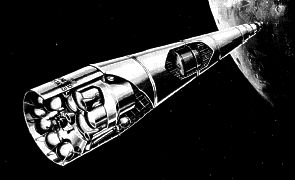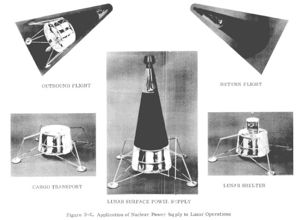
Home - Search - Browse - Alphabetic Index: 0- 1- 2- 3- 4- 5- 6- 7- 8- 9
A- B- C- D- E- F- G- H- I- J- K- L- M- N- O- P- Q- R- S- T- U- V- W- X- Y- Z
GE Lunar NEP Tug
 GE Lunar NEP Tug Credit: NASA |
Status: Study 1965.
A one-way trip from low earth orbit to low lunar orbit would take 3280 hours using electron-bombardment thrusters with a specific impulse of 4300 seconds. 28 metric tons could be delivered to the lunar surface by a chemically powered lander, as opposed to 13.4 metric tons for an all-chemical S-IVB/LLV system. The tug would only be used for unmanned cargo due to the long transit time, but would cut the number of Saturn V launches required to support the lunar base in half. The spacecraft could also land itself on the surface and serve as a power reactor for the lunar base.
CONTRACT NO. NAS 8-11207 \. GE NO. 65SD4361
ELECTRICALLY - SUSTAINED PROPELLED CARGO VEHICLE FOR LUNAR SUPPLY OPERATIONS
28 JUNE 1965
SUMMARY
The logistic support requirements for the manned lunar activities following the landings in the Apollo spacecraft system are subject to much debate. A reasonable prediction is that Apollo will be followed by a series of expeditions to various sites by use of vehicles derived from Apollo. It is also likely that one semi-permanent base would be established. In 15 years of post-Apollo activity, the "equivalent" logistic requirement could reach 2000 tons. This quantity could represent a conservative estimate for the subject analysis. The key element in the lunar logistics requirement is the transport of personnel. In a preliminary analysis, the number of Saturn V boosters required for transport of the men was found to equal approximately the number required for equipment and supplies. Thus, the "equivalent" tonnage, 2000 tons, is 50 percent equipment and 50 percent equivalent tonnage of personnel.
The electrically propelled space vehicle makes the orbit transfer in too long a time to participate directly in manned transportation. However, it can transport the lunar landing vehicle from earth to lunar orbit and the men can overtake it in lunar orbit by an all-chemical, rocket-propelled vehicle such as Apollo. Using this scheme, ten men plus 15 tons of equipment can be provided for a lunar expedition by the use of two Saturns. Using the all-chemical mode, 4-1/2 Saturns are necessary. As an alternative, a six-man team plus 25 tons of supplies could be transported for a six-month expedition using the "mixed" electrical propulsion and chemical rocket approach.
The nuclear rocket also provides a savings over a chemical rocket transport system. However, its savings is in the range of 28 percent as compared to 43 percent for the electrical propulsion system, at a 2000 ton "equivalent" cargo requirement. At this level of cargo the initial development cost is quickly absorbed, generally after 250 to 500 tons of cargo. The period of lunar expeditions will probably require on the order of 250 tons equivalent cargo, and this will amortize most of the development cost for either nuclear system. Both the development cost and the manufacture cost of the nuclear rocket and electrical propulsion systems affect the relative advantage of these systems over the chemical rocket. Equally important is the cost of the Saturn V, or the cost per unit mass to orbit. These cost factors are important to incorporate in the system optimization. The mission requirements for the earth-moon transfer are rather reasonable for an electrical propulsion vehicle. The propulsion requirement is defined by a characteristic velocity of 7.8 km/sec. Using a SNAP-50 type of powerplant with Beryllium radiators (specific weight at 10 kg/KWe) and electron bombardment ion engines (70 percent efficiency at 4000 seconds specific impulse), the trip time to transport a 30.8 ton net cargo lunar landing craft is 3280 hours. This represents a sizable cargo increase over the all-chemical Saturn V system (12.7 tons), but is achieved at the expense of greatly increased trip time (100 hours for all-chemical system).
Many operating modes are found to be of interest for the electrical propulsion system. One of the most interesting is the single-trip mode, because it attains most of the economic advantage of using electrical propulsion with the particularly advantageous feature of much shorter life requirements (in the range of 4000 hours). The multiple trip ferry needs at least 10,000 hours and preferably 15,000 hours for a 10 kg/KWe nuclear power supply. The operating mode comparison most difficult to evaluate is (1) the approach standardizing on a lander size, which requires varying specific impulses (and, thus, separate thrusters) between the different voyages legs, and (2) the approach restricted to a single specific impulse (a single thruster mounted to the powerplant) whereby different size lunar landers are provided on the initial, middle and terminal voyages. The constant specific impulse approach shows better performance with the cost model used herein, but this subject needs further study.
The multiple powerplant operational mode is an approach that eliminates the constant lander versus constant specific impulse controversy. An additional advantage is the inherent redundancy for improving reliability of cargo delivery.
Another consideration in the multiple-trip analysis is the dumping of spent propellant tanks from the inbound voyages in low earth orbit. The performance penalty has been estimated for carrying these empty tanks out to a high earth orbit or to lunar orbit, and this performance penalty is reasonably small. Thus, this approach can be taken if necessary or desirable.
The multiple-trip ferry did not have any substantial advantage over the single-trip mode. Thus, a reasonable approach is to direct the first generation lunar cargo vehicle development towards the single-trip mode. In this case the power supply life rating need not exceed six months, a more reasonable goal than the 10,000 hours discussed by many investigators. After the power supply is operational, the life rating can be increased by further development. The additional life rating of the power supply can be applied in any or all of four directions. The first is the multiple trip ferry with either single or multiple powerplants; the second is a lunar surface powerplant by retaining the powerplant with the lunar lander for descent from orbit; the third is the propulsion of unmanned probes and/or manned vehicles for interplanetary scientific voyages; and, finally, the fourth is the use as an APU in an orbiting satellite.
The most intriguing application for the extended life power supply is the lunar landing to provide surface power. A 1200 KWe power supply could be landed with a 2 pi shield plus 16 tons of equipment, forming a complete energy depot for ground operations or plant for manufacture of propellants from lunar resources. The power supply and lander with lunar surface shield is shown in Figure 2-2, along with many other views of the participating vehicles. This subject is also worthy of further investigation.
Family: Lunar logistics spacecraft, Space Tugs. Country: USA. Launch Vehicles: Saturn V. Agency: GE.
 | GE Lunar NEP Tug Credit: NASA |
Back to top of page
Home - Search - Browse - Alphabetic Index: 0- 1- 2- 3- 4- 5- 6- 7- 8- 9
A- B- C- D- E- F- G- H- I- J- K- L- M- N- O- P- Q- R- S- T- U- V- W- X- Y- Z
© 1997-2019 Mark Wade - Contact
© / Conditions for Use